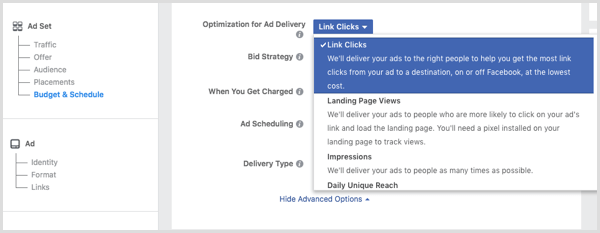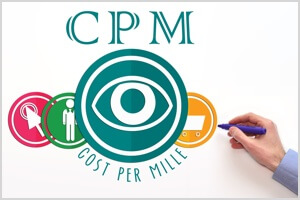Wondering if you should choose your bidding by link clicks (CPC) or impressions (CPM)?
In this article, you’ll discover how choosing bids for ads affects your Facebook ad campaigns.

#1: Create Your Campaign
The option to choose whether you get charged by link click (cost per click, or CPC) or impression (cost per mille, or CPM) is presented to you when you run a campaign based on the Traffic objective or the Conversion objective.
To create your campaign, choose either the Traffic or Conversion objective.

After you work through the campaign elements, open the Budget & Schedule section.
It's important to remember that how you're charged and the delivery action are two different things; don't get the two confused. If you choose to optimize ad delivery for Impressions, Daily Unique Reach, Landing Page Views, or Conversions, you can only be charged by impression.
To control how Facebook charges you for your ads, optimize your ad delivery for Link Clicks.

#2: Open Your Charge Type Options
To reveal the options for when you get charged, click Show Advanced Options in the Budget & Schedule section of your campaign.

You'll see two options next to When You Get Charged:
Get World-Class Marketing Training — All Year Long!
Are you facing doubt, uncertainty, or overwhelm? The Social Media Marketing Society can help.
Each month, you’ll receive training from trusted marketing experts, covering everything from AI to organic social marketing. When you join, you’ll also get immediate access to:
- A library of 100+ marketing trainings
- A community of like-minded marketers
- Monthly online community meetups
- Relevant news and trends updates
- Impressions
- Link Click (CPC)

#3: Choose Between Link Clicks and Impressions
When you opt to be charged by link click, you'll be charged by CPC. This means you'll only get charged when someone clicks a link in your ad. When you opt to be charged by impression, you'll be charged by CPM. This means you'll get charged every time an impression of your ad is shown, with the price calculated per 1,000 impressions.
Which is right for you?
 Pros and Cons of Choosing Link Clicks
Pros and Cons of Choosing Link Clicks
You only get charged when someone clicks your ad, so in theory, if your ad doesn't get many clicks, you'll initially be getting thousands of impressions for free. This charge type also acts as a safeguard against paying lots of money if your ad isn't performing well.
The downside is that if your ads perform well and you get a high click-through rate, you'll pay for every click. Your CPM will rise and you'll be paying a high price for that great performance. If you're not spending a lot of money and aren't running experiments with different audiences, sets, and ad variations, and are putting a lot of effort into optimization, choosing Link Clicks is likely a good option.
 Pros and Cons of Choosing Impressions
Pros and Cons of Choosing Impressions

Discover Proven Marketing Strategies and Tips
Want to go even deeper with your marketing? Check out the Social Media Marketing Podcast! Publishing weekly since 2012, the Social Media Marketing Podcast helps you navigate the constantly changing marketing jungle, with expert interviews from marketing pros.
But don’t let the name fool you. This show is about a lot more than just social media marketing. With over 600 episodes and millions of downloads each year, this show has been a trusted source for marketers for well over a decade.
When you get charged has nothing to do with how your ads perform. As mentioned above, selecting to charge by impressions means you can inadvertently waste money when your ads are performing poorly. But the opposite also applies. If your ads perform well and get a high click-through rate, you still pay only on a CPM basis.
Why is this a good thing? You can essentially “beat” Facebook's recommended CPC and pay a price per click that you would never achieve if you selected to charge by link click. This is a high-risk, high-reward proposition.
Why would you take the risk? If you have a big budget and are running a lot of audience splits and ad variations, a smart ad optimization strategy gives you a good chance of finding high-performing audiences and ads.
Which One Should You Select?
If you're just getting started with Facebook ads, don't have a lot of time to monitor your campaign performance, or are working with small budgets, link clicks is probably for you. It's a safe bet and you only pay for what you get.
Once you're comfortable with running campaigns and are more confident taking a hands-on approach to optimization by adjusting manual bids and daily budgets, you can graduate to being charged by impressions.
If you're comfortable optimizing Facebook ads, take a hands-on approach to monitoring your campaign performance, and work with medium to large budgets, CPM could reap big rewards. Experienced media buyers can see cost/performance ratio come down significantly.
Charge Type Affects How Facebook Serves Your Ads
Once your ads launch, they're entered into a blind auction against your competitors' ads. During this initial period, the performance of your campaign is critical. If the performance of your ads is poor (meaning you generate little revenue for Facebook in comparison to your competitors), your ads won't get good visibility. What does that mean for each charge type?
If you get charged by link clicks, Facebook makes money only when someone clicks a link in your ad. If your ad doesn't generate many clicks, you don't pay. Great for you, but bad for Facebook. It doesn't make any money, so very soon Facebook will stop showing your ads.

The above ad set had a high manual bid set to charge by link click. The low click-through rate means the effective CPM was only $0.24. That's not a lot of money for Facebook, so this ad set quickly stopped receiving impressions, however high the manual bid went.
If you get charged by impressions, Facebook makes money regardless of whether someone clicks a link in your ad. If your ad doesn't generate many clicks, you still pay. Bad for you, but good for Facebook. While Facebook wants to serve relevant high-performing ads, if it's making money from your ad, that ad will keep getting impressions.

The above ad set had a high manual bid set to charge by impression. The low click-through rate doesn't affect the CPM (which also results in a high CPC) so Facebook still makes money. This ad set continued spending money until it was turned off.
Want more like this? Explore Facebook Ads for Business!
Conclusion
The way you elect to be charged for your Facebook ad campaign impacts how your ads are served, whether your ads will continue serving despite poor performance, and if you'll pay a higher price for better performance.
The option for selecting charge type on Facebook is tucked away in an area of the campaign creation process that may not seem important. But that doesn't mean it's not.
Like many other aspects of Facebook advertising, taking control of this small element can have a big effect on your campaign. Understanding the differences between each charge type can help you choose the best option for you depending on your experience level.
What do you think? Will you adjust the way you get charged for Facebook Traffic or Conversion campaigns? Share your thoughts and questions in the comments below.
Attention Agency Owners, Brand Marketers, and Consultants

Introducing the Marketing Agency Show–our newest podcast designed to explore the struggles of agency marketers.
Join show host and agency owner, Brooke Sellas, as she interviews agency marketers and digs deep into their biggest challenges. Explore topics like navigating rough economic times, leveraging AI, service diversification, client acquisition, and much more.
Just pull up your favorite podcast app, search for Marketing Agency Show and start listening. Or click the button below for more information.


